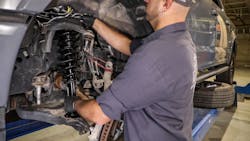Shipping Woes Are Hitting Auto Parts Hard, Says McCarron
This MTD exclusive was provided by Dennis McCarron, a partner at Cardinal Brokers, one of the leading brokers in the tire and automotive industry (www.cardinalbrokers.com).
As I write this column, the tell-tale signs of problems are already present. Back-orders of tires, which are nothing new, are becoming more frequent and deeper into SKUs.
With the proliferation of tiers of brands, you are likely to survive those instances in which your preferred brands are not available. But you can still help customers choose decent replacements for their vehicles.
Automotive parts and lubricants, on the other hand, are another story.
Hundreds of thousands of automotive parts are sitting off the California shore, waiting to be unloaded. But there are not enough dock workers to unload them. And even if there were, parts would sit idle, waiting for long-haul trucks to take them across the 48 contiguous states.
Because of this, local warehouses are struggling to meet what has essentially been a 10% to 15% increase in business across the independent tire dealership channel in 2021 versus 2020.
Perhaps this past summer you noticed that certain rotors were not available for certain vehicles. Then it was a few SKUs of rotors. A couple tie rod ends also went on back- order. I’m guessing a lot of parts are going to be difficult to come by.
I don’t think this is the end of the world, but we are about to hit a really big speed bump that is going to do a lot of damage to the underside of our economy.
Why is this a problem? It’s actually pretty simple. If you don’t have enough dock workers or truck drivers, product doesn’t move. We don’t have an actual shortage of auto parts. We have a gap in the ability to deliver those parts. And the problem isn’t going to get solved quickly. Truck drivers must have commercial driver's licenses and background checks have to be performed. And many drivers are soon going to age out of employment.
According to the U.S. Bureau of Labor Statistics, the average age of a truck driver is 55 years old. And 95% of those drivers are men. Even if the trucking industry were to drastically increase pay, improve work-life balance for drivers and include more minorities and women in the labor pool more effectively, you are still looking at a lead time of two to six months - at minimum - to train and license drivers.
All of this means you will have to control your inventory better, while shifting to processes that address parts shortages at the sales counter.
It must become common practice when writing up brake noises and shakes and shimmies and other vehicle ailments that the customer is at least informed of potential parts shortages.
You also - at the time of write-up - should check the availability of basic parts. I know this is not ideal. But this is the hand we have been dealt and checking availability is the most productive way to address the issue with your customers.
Some dealers may want to “stock up” on parts. While this might seem like a good idea at face value, for most owners, tying up cash flow for parts you don’t know if you will use could cause issues in your ability to buy tires or pay expenses on time.
During times like these, it’s important for independent dealers to remain nimble - not tied down financially.
Another key factor to consider is the fact that manufacturers continue to enact price increases. Passing increases onto customers is already happening. And delivery surcharges are being passed along, as well.
In no way, shape or form should a tire dealer ever absorb any price increases on tires or parts.
That said, you need to be empathetic to the sticker shock felt by the consumer as inflation sets in. Everything around them is getting more expensive and it’s frustrating. We demonstrate empathy as professionals by offering choices - and not through discounting.
In order to properly serve your customers and community, you must generate enough profit to make payroll and resupply your cash flow. Parts gross in our industry should always be in the 60% range.
Hopefully, 2021 has been a good year for your business. By most accounts, tire dealerships around the country have been up in total sales. And hopefully this added revenue has allowed dealerships to store a little extra cash in their coffers.
Managing your parts inventory - and managing customers’ expectations - will help you continue this positive momentum into next year and beyond.
About the Author

Dennis McCarron
Dennis McCarron is a partner at Cardinal Brokers Inc., one of the leading brokers in the tire and automotive industry (www.cardinalbrokers.com.) To contact McCarron, email him at [email protected].
